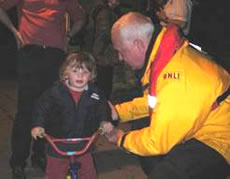Three year old found outside Bell and Crown Pub
|
The red phone rings, the full-time and volunteer crew members leap to their feet. One picks up the phone, which only the London coastguard can ring. The other two don their kit and hurtle down the ramp to the lifeboat mooring. By the time the third crewman has reached the boat the engines are running and the mooring lines released. The boat eases off the jetty then rapidly approaches its top speed of 40 knots. All this, 90 seconds after the first ring of the red phone.
On 12 November the Chiswick Lifeboat crew followed this routine for the thousandth time since the service started in January 2002. Helmsman Glen Munroe took the call at 17.02.
Six minutes later the lifeboat was two miles up-river at Strand–on the-Green. The Lifeboat crew started a systematic search for a missing three year old boy. He had been on his bike on the towpath and it was feared he may have gone into the river. The Coastguard had also summoned assistance from the Police boats and Helicopter. The lifeboat searched as night fell along the river bank following the flooding tide.
After half an hour the boy cheerfully reappeared after cycling half way to Brentford and back. The lifeboat still came alongside at the Bell & Crown pub where the boy had been found. Volunteer crew member John Pooley, who is a London Ambulance Service paramedic, ascertained that the boy was safe and well and the emergency services were stood down.
Once under way the crew contact the coastguard by radio to get further details of the call. The crew then get the appropriate equipment ready. For possible casualties the boat carries a comprehensive first aid kit, oxygen and entenox. There are blankets and spare clothes for people who have been in the water. A tow rope and salvage pump are used to recover vessels in trouble. With almost 500 horsepower on tap the lifeboat can tow 100 ton steel barges.
The lifeboat station has 10 full time crew members who work four days on four days off, and a group of forty volunteers who have all committed to serving at least two shifts a month. The crew are supported by a full time station manager and all the resources of the RNLI from its regional base in Ipswich and Headquarters in Poole.
Although the newest stations in the RNLI, the Thames lifeboats are by far the busiest. The nature of calls is different from the coastal stations. Chiswick lifeboats ‘customers’ include rowers, cabin cruisers, walkers stranded on the islands by the tide, houseboat dwellers who fall in and, sadly, a significant number of people in severe distress who come to the river to end all their problems. One of the crews’ most memorable calls was to a man who was determined to wade into the river and drown. A crew member coaxed him back to the shore. After some weeks of treatment and rehabilitation he came to visit the lifeboat station to thank the crew for saving him. He had come off drugs, got a job and was living a fulfilling life.
The RNLI has 233 lifeboat stations including four on the Thames. Chiswick RNLI lifeboat became operational on the 2nd January 2002. The four Thames lifeboats together have responded to over 3000 calls. The RNLI is entirely supported by voluntary contributions.
November 15, 2006
